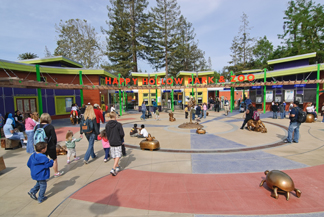Green and Happy

Photos: Copyright 2010 Jamie Pham.
SAN JOSE, Calif. — What do Leaping Lemur Trail, Giggle Grove, Doc’s Critter Care and Whistling Woods all have in common?
They’re all LEED Gold certified segments of downtown San Jose’s newly renovated $72 million Happy Hollow Park & Zoo. A part of the cityscape since 1961, the children’s park and zoo is one of three facilities of its kind to earn LEED Gold certification, according to the U.S. Green Building Council.
In redesigning existing spaces and adding approximately 12,8000 square feet of new park, including a new education complex, entry plaza, two more rides and 11 exhibits, landscape architects from The Portico Group in Seattle had to approach the project a little differently than they have other parks and zoos.
“The most significant difference was that this project was really targeted toward children ages 2 to 10,” says Paul Sorensen, associate principal, project manager and architect with The Portico Group. “And while other zoos, aquariums, and museums have children attending them, and have areas for those children, this park solely focused on that age group.”

Over a nearly five-year period of planning and waiting on $52 million in bond funds, set aside by the City of San Jose in 2000, the architectural firm developed a thematic approach that focused on creating exhibits which appealed to children’s unique perceptions.
The city’s goal in rehabilitating Happy Hollow was to modernize and bring existing spaces up to code, incorporate sustainable elements throughout the park and retain the venues’ existing charm and homespun feel.
Seven green roofs, growing some 56,000 plants, were added in the redevelopment. In addition to increasing Happy Hollow’s open spaces by 14,000 square feet, the green roofs naturally filter rainwater and reduce building cooling loads.
Other sustainable elements include porous asphalt surfaces, radiant flooring for the cooling and heating of buildings, recycled water used for non-potable purposes, and a storm water management system designed to keep all rainfall on the site.

Integrating the green components with the educational element of the park was important, says Sorensen. A park brochure and interpretational signs describe some of the sustainable elements of the park and provide a self-guided green tour. Tour stops include clerestory windows, which provide lighting and heating in all the buildings; a recycled base rock used throughout the project; and sustainable building materials.
“From the city side, we were asked to incorporate as many green elements as we could, within cost justification,” Sorensen says. “The education side said, ‘we want the sustainable features to come with interpretations.’ At the same time, the education side wanted the green components to be part of the children’s overall experience.”
“I think that’s what Happy Hollow really is – a unique balance of green elements combined with children’s educational exhibits,” he added.
West Bay Builders of Novato, Calif., served as the contractor on the entire project, while Gilbane Building Company, headquartered in Providence, R.I., operated as the bond fund manager. Renovations began in 2008 and were completed this summer.
